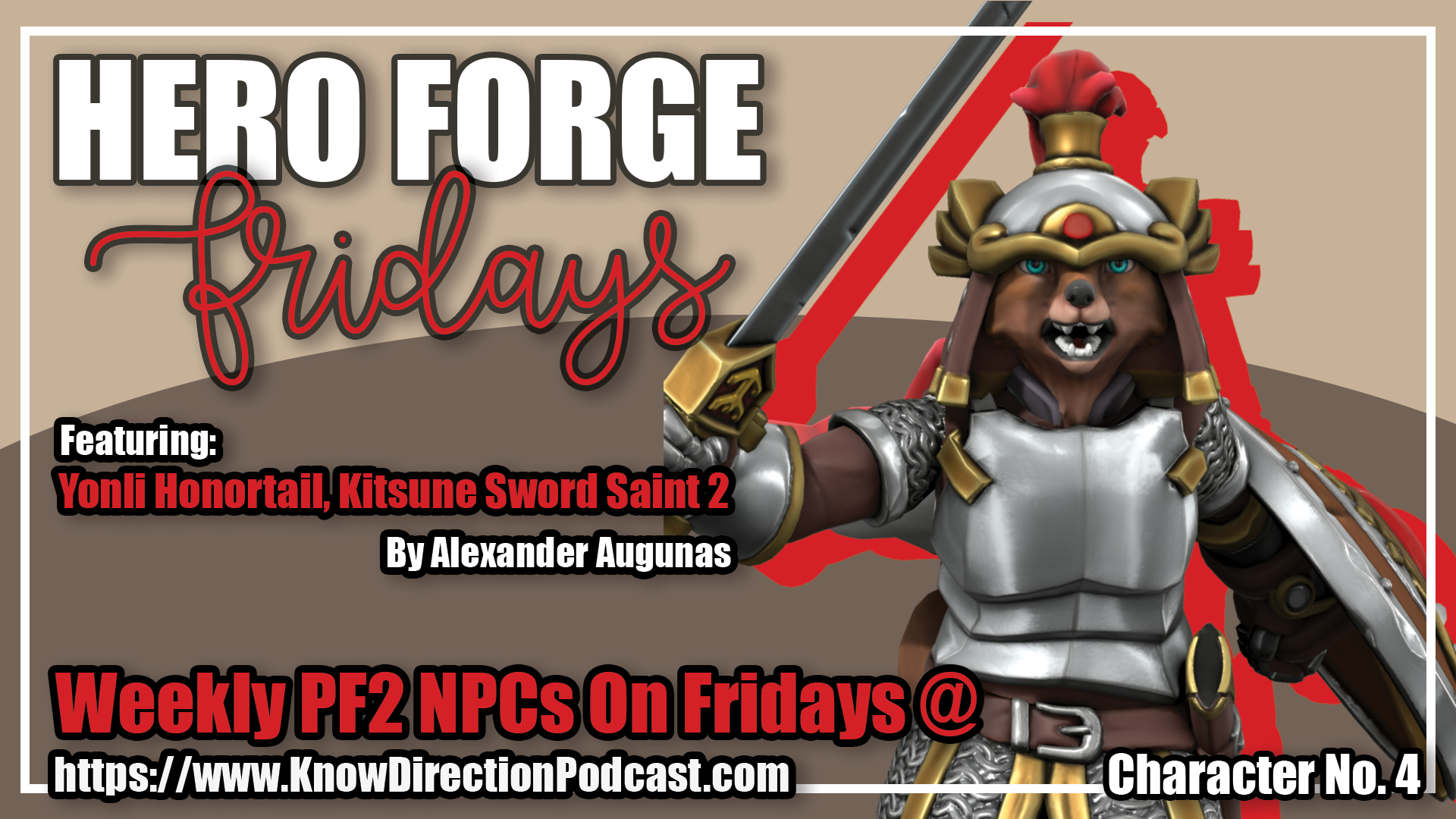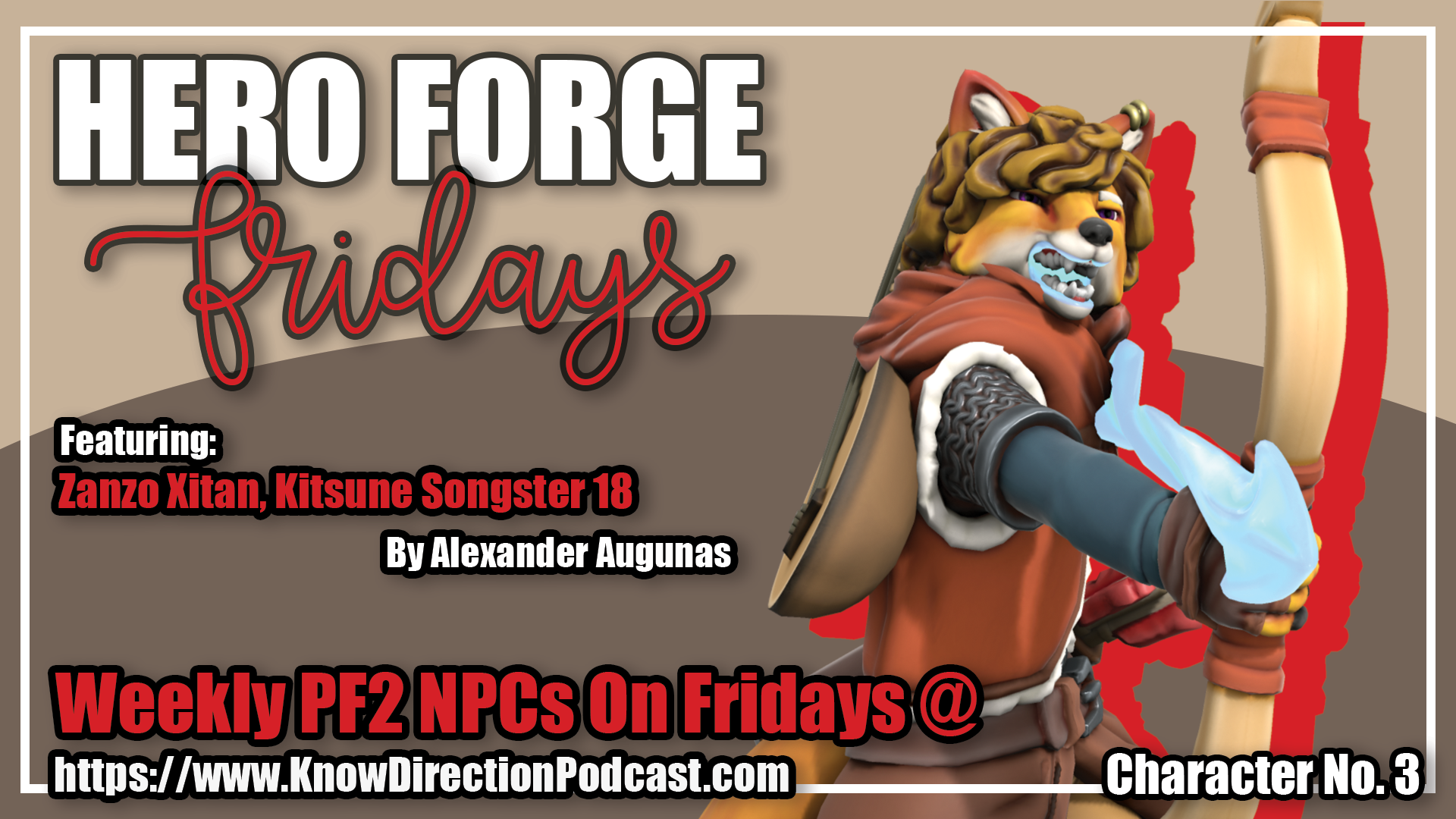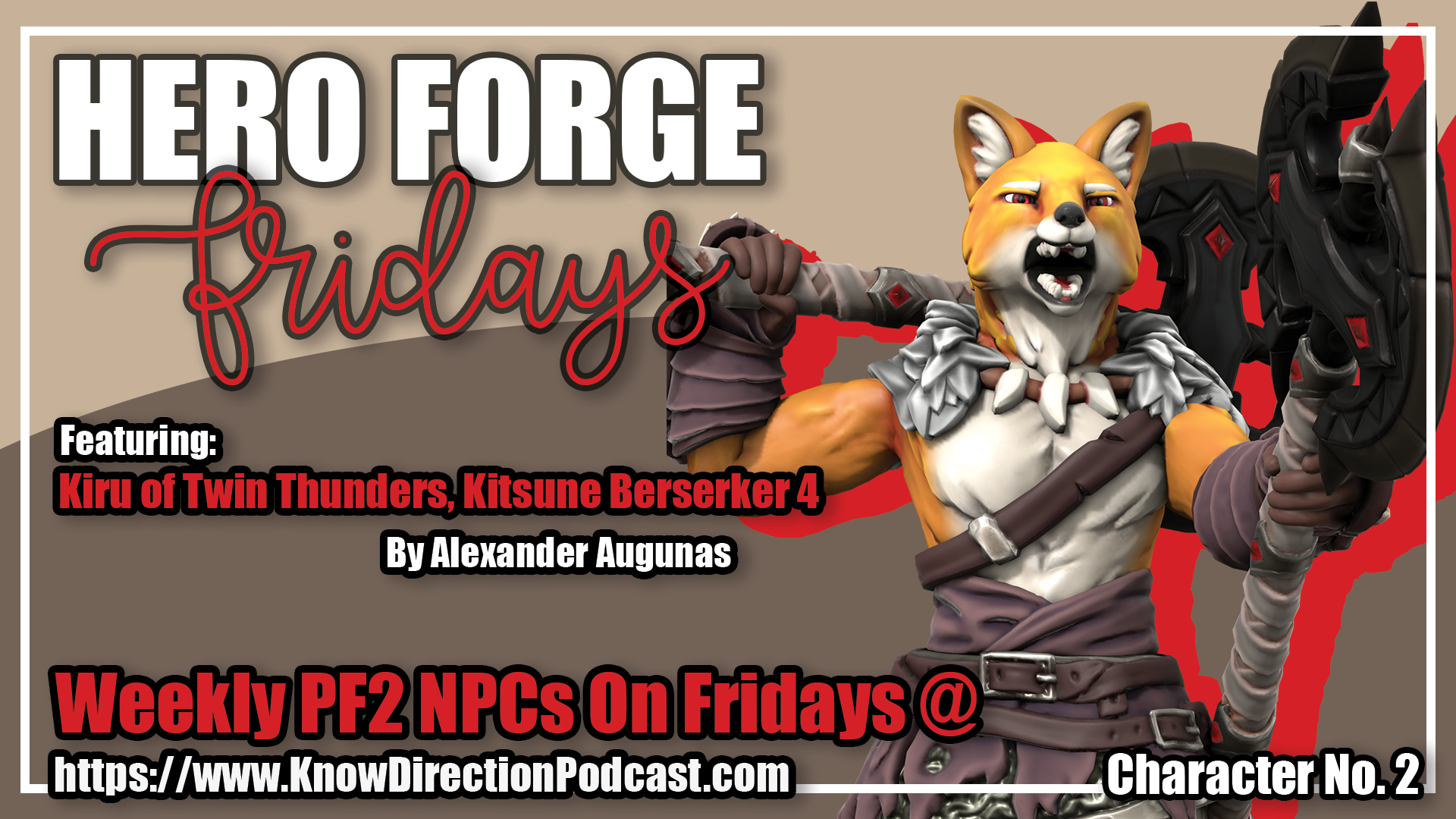Welcome to Iconic Design, Private Sanctuary’s source for innovative and evocative character builds for the Pathfinder Roleplaying Game, written by Everyman Gamer Alexander Augunas. Today, we’re going to be looking at TWO vigilante builds that Alex is considering for his PFS character.
So I felt really bad that I effectively didn’t give you an article last week (no I didn’t), so this week I’m going to make it up to you with TWO builds! Sort of.
As many of you might remember, I have a playtest vigilante named Cyril Takamine, aka the Bloodhound. Well, PFS Additional Resources have been updated, and now its time to rebuild him to make him compatible with the new Ultimate Intrigue rules.
BUT WHAT OPTIONS DO I TAKE?!
I’m down between two choices: sticking warlock like I was in the playtest or going stalker. And since the warlock is Logan Bonner’s brain child while Mark Seifter created the stalker, today on Iconic Design, its designer v. designer as we try to figure out WHOSE content I will be adopting for my character! Let’s do it!
Build Concept
Two builds, two concepts; let’s do it!
- Kitsune: Cyril is/was a kitsune. I’m not going to change that.
- Stalker: First option is to make Cyril a vigilante with the stalker archetype. This archetype is roguelike and features a special version of sneak attack, roguelike talents, and more. As a stalker, Cyril would take the duplicitous alternate racial trait from Inner Sea Gods for a sweet +2 racial bonus on Bluff and Disguise checks. (You’ll see why momentarily.)
- Warlock: Second option is to make Cyril a vigilante with the warlock archetype, which trades and alters a bunch of class features so he can cast spells and use mystic powers. This version of Cyril would keep the kitsune magic ability for its sweet, sweet +1 bonus on enchantment spell save DCs.
But enough about the general build; let’s do this thing!
Early Levels (1–7)
- Build 1
- Classes: vigilante 7
- Feats: Skill Focus: Bluff (1st), Weapon Finesse (Bonus), Two-Weapon Fighting (3rd), Weapon Focus: kukri (5th), Combat Reflexes (7th)
- Abilities: dual identity, seamless guise, social talents, startling appearance, unshakable, vigilante specialization (stalker; hidden strike +4d8), vigilante talents
- Social Talents: social grace (1st), double time (3rd), in vogue (5th), quick change (7th)
- Vigilante Talents: lethal grace (2nd), canny feint (4th), leave an opening (6th)
- Build 2
- Classes: vigilante (warlock) 7
- Feats: Point-Blank Shot (1st), Precise Shot (3rd), Rapid Shot (5th), Two-Weapon Fighting (7th)
- Abilities: dual identity, mystic bolts (acid, electricity), piercing bolts, seamless guise, social talents, startling appearance,
- Social Talents: social grace (1st), double time (3rd), in vogue (5th), quick change (7th)
- Vigilante Talents: arcane striker (2nd), tattoo chamber (6th)
- Spells: As a 7th level magus (3rd level spells), using the sorcerer/wizard spell list.
Okay, let’s start with the stalker. This build is focused around feinting, though not initially. At 1st level, the build assumes that you’re grabbing Weapon Finesse, then taking the Lethal Grace talent at Level 2. This will allow you to immediately trade out your Level 1 feat, which you can use to pick basically anything you want provided you could take it at Level 1. I like bluffing people, so Skill Focus: Bluff is my choice for the purpose of this guide, though Improved Initiative seems pretty awesome too. Weapon-wise, I’m planning on going kukri for crit-fishing because critical hits are fun, but the gladius is also a REALLY great weapon because it can be used for piercing or slashing, so I’m keeping that in mind as well. Featwise, the initial idea is to feint stuff with canny feint, which lets me feint as a move action, and eventually building into leave an opening, so if I feint you and sneak attack you, I get to feint you and sneak attack you again at the start of my next turn. Pretty nifty, though its honestly a compelling argument to switch from kukris to gladiuses; a 1d4 attack that might not be a hidden strike isn’t super compelling.
Switching over to the warlock build, my build is ranged-focused and starts by getting all of the important “thrown feats;” Point-Blank, Precise, Rapid Shot, and Two-Weapon Fighting. By the time I’m 7th level, that’s three touch attacks with a bonus of Dex modifier +0. Not great, but that’s why touch attacks are awesome, right? My energy types are going to be electricity because its cool and acid because its practical (few things are resistant to acid), and I’m picking up Arcane Striker as my first talent so I can have Arcane Strike as a bonus feat. At 6th level, I’m grabbing tattoo chamber because MY GOD THE ACTION ECONOMY ON THIS IS AMAZING. Tattoo chamber is great, and in my original build I had to wait a LONG time for it, so this is helpful. In addition, I can cast spells like a 7th-level magus using the sorcerer/wizard spell list. I miss the arcanist casting, but I have SO many more spells at my disposal now that its unreal. I would have liked an option to cast like a bard instead of a magus (I prefer spontaneous casting), but it is what it is. It is worth noting that as a warlock, you need never prepare a damge-dealing spell in your life. Why bother when you have mystic bolts? Instead, I will be using my spells per day to prepare controlling spells that let my character do things like drop foes into places where they become less effective (create pit) or paralyze them outright (hold person).
From a quick glance, its clear to see that the stalker has better damage and a more robust fighting style, but the warlock is the clear winner in the battle of versatility. At this point in the game, I find myself liking the stalker build a bit better because it syncs up PERFECTLY with the kitsune’s racial bonuses; that’s a small thing to like, especially considering we’re only talking about being one ability score off with the warlock, but it is worth considering. Let’s keep it in mind when we’re looking at the mid levels.
Mid Levels (8 –14)
- Build 1
- Classes: vigilante 14
- Feats: Skill Focus: Bluff (1st), Weapon Finesse (Bonus), Two-Weapon Fighting (3rd), Weapon Focus: kukri (5th), Combat Reflexes (7th), Improved Two-Weapon Fighting (9th), Improved Critical (11th), Power Attack (Bonus), Critical Focus (13th), Blind-Fight (Bonus), Improved Blind-Fight (Bonus)
- Abilities: dual identity, frightening appearance, seamless guise, social talents, startling appearance, unshakable, vigilante specialization (stalker; hidden strike +7d8), vigilante talents
- Social Talents: social grace (1st), double time (3rd), in vogue (5th), quick change (7th), immediate change (9th), many guises (11th), mocking jay (13th)
- Vigilante Talents: lethal grace (2nd), canny feint (4th), leave an opening (6th), surprise strike (8th), inspirational vigilante (10th), shield of blades (12th), strike the unseen (14th)
- Build 2
- Classes: vigilante (warlock) 14
- Feats: Point-Blank Shot (1st), Precise Shot (3rd), Rapid Shot (5th), Two-Weapon Fighting (7th), Weapon Finesse (9th), Ranged Feint (11th), Improved Two-Weapon Fighting (13th)
- Abilities: dual identity, mystic bolts (acid, electricity), piercing bolts, seamless guise, social talents, startling appearance,
- Social Talents: social grace (1st), double time (3rd), in vogue (5th), quick change (7th), immediate change (9th), many guises (11th), mocking jay (13th)
- Vigilante Talents: arcane striker (2nd), tattoo chamber (6th), cunning feint (12th)
- Spells: As a 14th level magus (5th level spells), using the sorcerer/wizard spell list.
So stalker first again. Talent-wise, the stalker gets a LOT of cool abilities post Level 7. Surprise strike is AWESOME for a feinting-heavy character, as it gives a scaling attack roll bonus against foes that are denied their Dexterity bonus to AC. The vigilante doesn’t have many ways to gain offensive bonuses like that, so surprise strike is much-needed when its picked up. After that, inspirational vigilante. This was originally a talent I overlooked, but its worth mentioning that this talent scales EXTREMELY well. A standard investigator gets a number of inspiration uses equal to his Intelligence + 1/2 his level and can use inspiration for free on any Intelligence-based skill that he’s trained in. A vigilante, on the other hand, gets no free uses but instead gets one use per level. This means that early on (level 2), the investigator is going to have so many more uses that this talent isn’t worth taking. But at Level 4, my investigator has a total of five uses (+3 Int and 2 from level) while a vigilante would have 5. As the vigilante levels, he quickly outpaces the investigator in inspiration uses, which is what makes this ability worth it; the investigator is more about getting uses for free on skills while the vigilante is about having a LOT of uses for a lot of different things. After that, I took shield of blades (Power Attack sans prerequisites AND a bonus to AC when I Power Attack? Okay.) and strike the unseen, which is a bucket of bonus feats. I’m not convinced that Power Attack is the talent that this build needs, since all those Two-Weapon Fighting feats I have come at a hefty attack roll penalty, however.
Let’s shift over to the warlock. I decided to pick up Weapon Finesse at Level 9 and Ranged Feint at Level 11; the reason I took Weapon Finesse first is that my build won’t have canny feint until Level 12, and ranged feint doesn’t do much until then. Its worth mentioning that Ranged Feint is AWESOME; it is literally the feat that archer rogues everywhere have needed to be competitive (I’ll show you a new archer rogue build next week to prove it), and I’m happy to have it here. I’m also picking cold as my new energy type for 13th level, because in my experience more things are resistant/immune to fire, which means vulnerability to cold is more common too.
The differences between these builds are stark and fairly well balanced. The stalker is still REALLY good at damage, and the sheer number of cool abilities he has over the warlock is tempting. The warlock has CL 14 with 6th-level wizard spells in his corner, however, and a neat “ranged feinting with mystic blasts” mechanic that is tempting, though I’m not sure if its worth sticking around this long for.
Let’s check the endgame and see.
Endgame (15+)
- Build 1
- Classes: vigilante 20
- Feats: Skill Focus: Bluff (1st), Weapon Finesse (Bonus), Two-Weapon Fighting (3rd), Weapon Focus: kukri (5th), Combat Reflexes (7th), Improved Two-Weapon Fighting (9th), Improved Critical (11th), Power Attack (Bonus), Critical Focus (13th), Blind-Fight (Bonus), Improved Blind-Fight (Bonus), Greater Two-Weapon Fighting (15th), Greater Blind-Fight (Bonus), Bleeding Critical (17th), FREEBIE (19th)
- Abilities: dual identity, frightening appearance, seamless guise, social talents, startling appearance, stunning appearance, unshakable, vengeance strike, vigilante specialization (stalker; hidden strike +7d8), vigilante talents
- Social Talents: social grace (1st), double time (3rd), in vogue (5th), quick change (7th), immediate change (9th), many guises (11th), mocking jay (13th), case the joint (15th), everyman (17th), any guise (19th)
- Vigilante Talents: lethal grace (2nd), canny feint (4th), leave an opening (6th), surprise strike (8th), inspirational vigilante (10th), shield of blades (12th), strike the unseen (14th), close the gap (16th), shadow’s speed (18th), hide in plain sight (20th)
- Build 2
- Classes: vigilante (warlock) 20
- Feats: Point-Blank Shot (1st), Precise Shot (3rd), Rapid Shot (5th), Two-Weapon Fighting (7th), Weapon Finesse (9th), Ranged Feint (11th), Improved Two-Weapon Fighting (13th), Greater Two-Weapon Fighting (15th), Weapon Focus: mystic bolt (17th), FREEBIE (19th)
- Abilities: dual identity, mystic bolts (acid, electricity), piercing bolts, seamless guise, social talents, startling appearance, stunning appearance, vengeance strike, vigilante talents
- Social Talents: social grace (1st), double time (3rd), in vogue (5th), quick change (7th), immediate change (9th), many guises (11th), mocking jay (13th), case the joint (15th), everyman (17th), any guise (19th)
- Vigilante Talents: arcane striker (2nd), tattoo chamber (6th), cunning feint (12th), surprise strike (18th), inspirational vigilante (20th)
- Spells: As a 20th level magus (6th level spells), using the sorcerer/wizard spell list.
Endgame!
Both builds end strong by picking up their respective Greater Two-Weapon Fighting feats; arguably that’s better for the vigilante, who is shooting at touch AC with a +3 benefit from feinting thanks to the surprise strike vigilante talent, but surprise strike doesn’t come online until 18th level for the warlock. Stalker picks up a massive +20 ft. bonus to movement speed, Greater Blind-Fight, and an ability that allows him to completely shut down attacks to make attacks of opportunity against him while he’s moving. Despite the number of talents the warlock possesses, he runs out of cool things to take at the end-game, and his number of special abilities still feels rather limited because of the number of talents that get spent on spellcasting. That said, this version is playable compared to the playtest, and because you lose a lot of cool vigilante talents for spellcasting, I personally feel that these two choices come out being pretty close power-wise. They’re good at different things in different ways, but overall they’re both functional.
That’s what makes this choice so hard….
So while I’m agonizing over choices, what do you think? Which of these two builds is mechanically superior? Which looks like more fun? Which do you think I should use for my vigilante’s PFS build? Leave your questions below, and I’ll see you back on Monday for another installment of Guidance as Intriguing April continues! Take care.
Alexander “Alex” Augunas has been playing roleplaying games since 2007, which isn’t nearly as long as 90% of his colleagues. Alexander is an active freelancer for the Pathfinder Roleplaying Game and is best known as the author of the Pact Magic Unbound series by Radiance House. Alex is the owner of Everyman Gaming, LLC and is often stylized as the Everyman Gamer in honor of Guidance’s original home. Alex also cohosts the Private Sanctuary Podcast, along with fellow blogger Anthony Li, and you can follow their exploits on Facebook in the 3.5 Private Sanctuary Group, or on Alex’s Twitter, @AlJAug.



